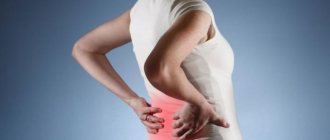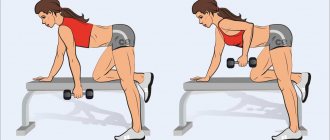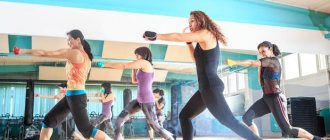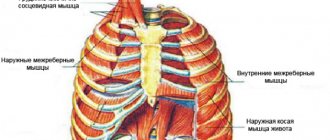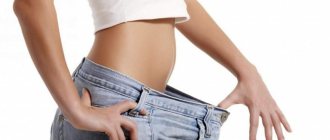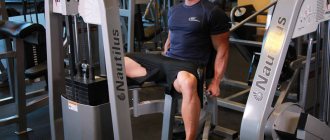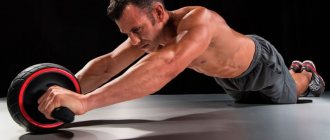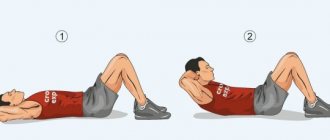What exercises cannot be combined: squats and deadlifts
These exercises are very similar in technique.
They differ in the position of the weight (on the shoulders or on the floor) and, as a rule, in the position of the legs. Both exercises are complex, involving the legs, buttocks, and back. Therefore, the opinion arose that for one workout, two heavy exercises for the same muscle groups are too much. “If you work out with maximum weights in all exercises, then it’s really not recommended to combine squats and deadlifts in one workout,” explains Ksenia Shulga, an expert in the group programs of the federal network of fitness clubs X- Fit . “In this case, you can perform the first exercise with maximum weight, and in the second use a weight 30% lower than the maximum.”
About the muscle groups involved in back squats and deadlifts
Squats and deadlifts are the main movements of triathlon and the results of these movements directly determine the success of a powerlifter’s training and performances.
In the process of preparation, especially when general physical training complexes are planned, there is a need to clearly understand which muscles need to be directed to this or that portion of stress. In accordance with this, there is a direct need to understand the importance of individual muscles in the overall success of the exercise, as well as in the effectiveness of individual motor phases. Both when performing deadlifts and during squats, a powerlifter uses almost similar muscle groups: shoulders, back and torso, front and back surfaces of the thighs, and lower legs. However, their emphasis and mode of operation differ significantly - this follows from the differences in joint angles and load vectors.
General principles of muscle work in squats and deadlifts
If we are talking about the muscles that are directly involved in the performance of squats and deadlifts, then it is better and more appropriate to begin the presentation with a description of the back muscles. Those who bear the main load in these movements can be identified:
- Superficial back muscles of the first layer Trapezius back muscle;
- Latissimus dorsi muscle.
- Rhomboid minor;
- Erector spinae muscle;
When an athlete has the correct technique, then during both deadlifts and squats, the back muscles work with a small change in their length. The greatest change in length (shortening) can be observed in the deadlift at the moment of fixation in the final position, when the athlete abducts the shoulders and straightens the back. The leg muscles, on the contrary, actively change their length both during deadlifts and squats. This determines the differences in the work of these muscles: the leg muscles experience a predominantly dynamic nature of the load and work in an overcoming mode, while the back muscles work mainly in a static mode, that is, they hold the torso in a certain position.
Human back muscles
When training, as a rule, athletes divide the muscles conditionally into the muscles of the upper back (trapezius, rhomboid, teres, latissimus muscles) and the lower back (erector spinae, transverse spinalis, spinalis). This division is designed to clearly identify the athlete’s weak points when significant failures occur during the movement.
During squats, the athlete’s back remains straight, providing a natural position for the spine. This position is achieved by tensing the back muscles
When performing both squats and deadlifts, the athlete must maintain a straight position of the thoracic and lumbar spine, and if these positions are violated, the muscles that lead to the occurrence of flaws can be clearly identified. Thus, if the natural position of the thoracic spine is disturbed, we are talking about weakness of the muscles of the upper back, while violations of the position of the lower part indicate weakness of the muscles of the lower back. Such violations can occur both during squats and deadlifts. In squats, back curvature occurs mainly in the pre-squat phase, and in deadlifts it often occurs after the start of the movement, when the bar lifts off the platform.
During the performance of deadlifts and squats, the most important task of the athlete is to maintain the correct physiological position of the spine, in which it does not significantly change its original position. During this task, the abdominal muscles also join the back muscles:
- Muscles of the anterior abdominal wall Rectus abdominis;
- External oblique abdominal muscle;
- Quadratus lumborum muscle.
The abdominal muscles also do not actively change their length during the exercise; accordingly, their mode of operation is also predominantly static to keep the body in the correct position. If we talk about the participation of the abdominal and back muscles in fixing the required position of the body and spine, then the load is distributed approximately 65:35% in squats in favor of the back muscles and approximately 75:25% in deadlifts, also in favor of the back muscles. Considering the forward shift of the force vector when performing deadlifts, the load on the back muscles increases significantly, while during squats it is predominantly axial in nature, which determines less load on the back, but at the same time the need to constantly keep the torso in a position close to vertical increases, which determines the increased load on the abdominal muscles.
Maintaining the torso in the required position during the deadlift is carried out due to the static tension of the muscles of the back and abdomen
During squats and deadlifts, the muscles of the lower extremities are actively involved in the work. The main load is borne by:
- External pelvic muscle group Gluteus maximus;
- Gluteus medius;
- Gluteus minimus;
- Quadratus femoris muscle.
- Iliopsoas muscle;
- Sartorius;
- Pectineus muscle;
- Biceps femoris (biceps femoris);
In order to optimize the training effect, all the muscles of the pelvis and legs are combined into two groups: the muscles that extend the lower leg (quadriceps, sartorius, adductors, etc.), as well as the muscles that extend the torso (biceps, gluteal, semitendinosus, etc.). When analyzing the performance of deadlifts and squats, it becomes clear that extension of the lower leg (straightening the leg at the knee joint), as well as extension (straightening) of the torso are the main motor tasks of both squats and deadlifts. The differences between these movements consist primarily in the load vectors. So, when performing deadlifts, the deadlift vector of the load is shifted forward and the further it is removed from the body line, the greater the load on torso extension . When squats, the load is predominantly axial, which causes greater involvement of the muscles that perform leg extension (straightening the legs at the knee joints).
Thigh muscles
Regardless of the starting position and technical style, in most cases, the deadlift begins with extension of the legs at the knee joints, with a constant torso angle. This movement is performed primarily by the anterior thigh muscles (quadriceps), as well as the medial one when using sumo-style rows. After passing the level of the knee joints, the main motor task of the athlete is to straighten the torso, extending the hip joint. This problem is solved through the active work of the external pelvic muscles (gluteus maximus, medius, minimus), as well as the posterior thigh muscles (femoral biceps).
Regardless of the technical style of deadlift, after passing the level of the knees, the athlete’s main task is to straighten the torso at the hip joint. This task is solved using the posterior thigh muscles
As already mentioned, the back muscles predominantly experience static load during both exercises. The latissimus dorsi, trapezius, and erector spinae muscles slightly reduce their length during the final phase of the deadlift. In this case, the more the body is tilted forward, the greater the static load This forces the athlete to maintain the same vertical speed of movement of the shoulders and pelvis while performing both exercises.
When performing squats, the tension in the back muscles is constant: the athlete should achieve maximum contraction of both the upper and lower back muscles in order to ensure maximum rigidity of the spine line already in the starting position. When the lumbar back arches, the center of gravity of the athlete-barbell system shifts back, which leads to imbalance, so it is recommended to slightly tilt the torso forward by bending the torso (leaning forward) at the hip joint when the athlete takes the starting position.
The back muscles are under maximum tension during squats. Such tension must be conscious: at the start, the athlete brings his shoulder blades together and arches his back, ensuring maximum rigidity of the spine line. The muscles are in this position throughout the entire movement.
Separately, it is necessary to say about the lower leg muscles, which, although they do not make a significant contribution to the success of squats or deadlifts, nevertheless function as stabilizers or direct movers during withdrawal and alignment in the pre-start phase of squats. Accordingly, the following muscles can be distinguished as defining muscles:
- Anterior group of muscles of the lower leg Anterior tibialis muscle.
- Peroneus longus;
- Calf muscle;
In squats, the lower leg muscles work actively while moving away from the barbell rack; The work primarily involves the gastrocnemius and soleus muscles, which flex the lower leg and foot. In addition, these muscles are actively involved in the work when it is necessary to shift the lower leg back, when performing squats or deadlifts.
Squats and deadlifts also use the forearms . In squats, they are associated with holding the bar in the required position, while in deadlifts they directly hold the projectile. The latter is performed due to the static tension of the muscles that perform flexion of the hand and fingers.
Special cases of accentuated muscle work in squats and deadlifts
Since the degree of development of target muscle groups varies among different athletes, there is a necessary need to make technical changes that will improve the results in a particular movement. Accordingly, both squats and deadlifts can be performed with different leg positions, which will determine excellent engagement of the target muscles.
Among powerlifters, the “sumo” style of performing deadlifts is currently widespread, when the legs are placed wider than the shoulders, and the grip of the bar is performed so that the hands are between the knee joints. When the hands are on the outside and the legs are positioned narrow, the athlete performs classic deadlifts. The differences in the muscular work of these technical deadlift styles result from changes in leverage and force vectors, which are a normal consequence of changing techniques.
So, in the classic version, the athlete’s torso is strongly tilted forward, and the pelvis is located very far from the barbell. The knees are spread to the sides, but the angle of separation is insignificant. Under such conditions, the main muscular effort will be directed toward straightening the torso, and accordingly, the load will fall to a greater extent on the thigh muscles that straighten the torso (gluteus, biceps femoris), as well as the back muscles.
Two different starting positions for the deadlift are given. The first picture characterizes a significant degree of forward tilt of the torso - in this case, the load will fall heavily on the gluteal and hamstrings, in addition, the static load on the back will increase. The second case characterizes the convergence of the pelvis and the projectile, a greater squat - here the quadriceps will receive the load.
If we are talking about a “sumo” style performance, when the athlete puts his legs wide and grabs the apparatus so that his hands are between his knees, then the load on the muscles will be changed to some extent. Thus, a smaller angle of inclination of the torso forward, characteristic of sumo deadlifts, will place less load on the back, as well as the gluteal and hamstrings. The shift of the pelvis forward to the bar, which ensures the convergence of the centers of mass of the athlete and the apparatus, usually causes stronger flexion of the legs at the knee joints, which increases the involvement of the muscles that perform leg extension (quadriceps femoris). In addition, by spreading the feet and knees, the muscles of the medial group of thigh muscles (adductor magnus and longus) will be actively involved in the work.
When using sumo style, load distribution also depends on the initial leverage. So in the first case, due to a greater forward bend, the hamstrings will receive an accentuated load; in addition, the flexion load on the spine will increase, increasing the force of the back muscles to maintain the correct body position. In the second case, due to the approaching angle of the torso to the vertical, the load on the back will decrease, but will increase for the anterior and medial thigh muscles.
As a general position, the following can be distinguished: the greater the angle of inclination of the torso during the movement, the greater the load placed on the muscles that extend it (biceps femoris, gluteal muscles) and the less on the extensor muscles of the lower leg (quadriceps). This fact is actively used by many athletes who, in search of more power, trying to involve more muscles in the work, perform a strong forward bend of the torso when lowering into a squat, in order to thus equalize the load on the quadriceps and hamstrings during squats with a barbell.
With various variations of barbell squats, a roughly similar picture of the redistribution of muscle efforts is observed, but a number of interesting facts should be noted. As a rule, athletes in powerlifting try to move the pelvis back more during squats - this makes it possible to perform a do-squat with less bending of the legs at the knee joints (the forward displacement of the knee is reduced) and, accordingly, reduce the load by reducing the overall amplitude. This measure forces the athlete to compensatoryly shift the torso forward - this is a condition for maintaining balance, since it is achieved only when the projection of the bar passes through the middle of the foot. The use of a wide position of the legs, in turn, although it uses the adductor muscles of the thigh to a greater extent, nevertheless, unlike a narrow position, it not only reduces the movement of the pelvis back when lowering, but also practically neutralizes the displacement of the lower leg (and knee) forward, creating the most optimal conditions for sitting. Reducing the backward movement of the pelvis significantly reduces the load on the femoral biceps, which, other things being equal, would be greater if the athlete used a squat in a narrow or medium position of the legs.
Thus, when performing squats in a wide stance, the athlete seems to exchange the force of the anterior and posterior thigh muscles for the force of the medial group, making the contribution of the adductor muscles more significant.
A wide-legged squat provides optimal conditions for a sit-up by neutralizing the forward motion of the shin and shifting the pelvis forward. Due to this, the load on the back and posterior thigh muscles is also reduced, and the lower leg muscles are unloaded. However, this technical style is demanding on the strength of the anterior and medial thigh muscles.
When performing deep squats in a narrow position, the forward displacement of the lower leg is maximum, which causes not only a strong stretching of the anterior thigh muscles, but also a significant involvement of the soleus muscle of the lower leg. This is explained by the fact that the forward displacement of the lower leg increases significantly and there is a need to straighten the foot, which is carried out mainly by the soleus and gastrocnemius muscles.
The variety of muscles involved in various motor acts is sometimes truly amazing and is explained primarily by the complexity and versatility of the human muscular system. However, by combining them into groups according to the functions performed in the process of simple motor acts, it is possible to significantly simplify the mechanisms of these processes and acquire a stable understanding of the anatomical composition of various exercises in powerlifting and other sports disciplines.
To write the article, information was used, as well as illustrations from the following literary sources: Atlas of Human Anatomy: A textbook for medical schools. – M.: RIPOL classic, 2006. – 528 p.: ill. “Get strong! Book 3” Looking S. A., Starov M. A., Batygin Yu. V.
What exercises cannot be combined: exercises for triceps and pectoral muscles
Triceps work should not be done before chest exercises. “The triceps is a synergist for the pectoral muscles; it “helps” them perform the exercise,” explains Ksenia Shulga. “At the same time, the triceps are usually weaker, so it is not logical to load it before working on the thoracic region.” However, experienced fitness athletes may have individual goals, and sometimes they want to load the triceps more than the chest. For example, when preparing for the gymnastic elements of CrossFit or for explosive muscle growth. So training the triceps to the chest in general is not prohibited.
Why do you need equipment?
Powerlifting athletes can use equipment to improve their performance. This includes athletic tape, special shoes, weightlifting belts, knee pads and wristbands.
As technology for the production of sports equipment developed, powerlifters began to be divided into two categories:
- athletes using support equipment;
- athletes performing in regular sportswear.
In practice, raw powerlifting means that athletes are only allowed to use federation-approved belts, clothing, and wristbands in competition.
An equipped powerlifter uses additional equipment to protect the body and increase the weight lifted: special tights and a shirt for performing bench presses.
The newest equipment allows the athlete to lift more weight than he would otherwise be able to lift, up to approximately 115% of his maximum level. The equipment used varies from federation to federation.
Special flat shoes allow the powerlifter to distribute weight through the back of the foot. Their soles are stickier than most regular shoes and prevent slipping.
When performing bench presses, flat shoes are not as beneficial, and many athletes prefer shoes with an elevated heel.
Powerlifting suits are made from one or more layers of fabric with high tensile strength. When an athlete takes the starting position for a deadlift or squat, the fabric of the suit stretches and tends to return to its starting position. Therefore, when performing an exercise at the top of the lift, the suit helps the athlete hold the weight.
- When used correctly, a weightlifting belt significantly increases core stability and reduces the risk of injury.
- Wristbands are most often used during bench presses or squats. They help stabilize the wrist and allow powerlifters to lift heavier weights safely and more comfortably.
What exercises cannot be combined: straight-legged deadlift and hyperextension
If you include such a useful lower back exercise as hyperextension in your training, then it’s really better to avoid straight-legged deadlifts altogether. “Replace it with the Romanian deadlift exercise, which is performed in the set-position position, that is, with slightly bent knees,” advises Ksenia Shulga. “This way you will avoid overstretching your hamstrings.” It is logical to first work the lower back muscles with hyperextension, and then move on to a more global work of the back and buttocks in the form of the Romanian deadlift.
What exercises should not be combined: squats, lunges, deadlifts and bench presses
All these exercises are complex, maximally using all the muscles of the body. The first three put more strain on the legs, buttocks and back, while the upper shoulder girdle also does not rest, but works to maintain hold.
The bench press primarily works the chest, upper shoulder girdle, and back. But all these exercises are hard, they make you very tired. This is related to the opinion about dividing them into different training days.
“It’s better to combine them only if you have little time to go to the fitness club,” agrees Ksenia Shulga, “and you have to get the most out of each workout. And try not to use maximum weights, try different modes of operation. Usually it is recommended to really differentiate these exercises by performing them on different days of the week.”
What exercises cannot be combined: pull-ups, push-ups, bench presses, standing and sitting
The first exercise maximally utilizes the back, as well as the upper shoulder girdle and arms. Push-ups are an exercise for the chest and triceps, including, depending on the technique, the shoulders. The bench press is primarily an exercise for the chest, standing and seated for the shoulders, but they all also work the back muscles. “They complement each other perfectly, so they can be performed in one workout,” says Ksenia Shulga. “It is recommended to perform the bench press standing first and then sitting, as the former is more difficult to perform.”
History of the 5x5 program
The basics of the 5x5 program were compiled by Arnold Schwarzenegger's mentor Reg Park in 1960.
Many people have written about it over the past 60 years, so I didn't invent anything new.
I came across the 5x5 program in 2003. Then I trained up to 6 times a week, spending 2 hours in the gym, reaching muscle failure in each set and experiencing muscle pain every day. Unfortunately, I did not know any other training approaches.
Over time, I realized that I have large but weak muscles. After a long search for a solution to the problem, I discovered that to develop strength you need:
- Use free weights, not machines.
- Perform multi-joint exercises that do not isolate.
- Increase working weights without achieving pumping and without causing muscle pain
Everything became clear to me. I started looking for a program that would make me stronger. On one forum, a guy recommended the good old “5x5” to me.
I tried it, and I was very pleased with the results. Since then, the program has become the basis for my training.
What exercises cannot be combined: overhead press and overhead squats
The barbell overhead press is the standing press that has been mentioned more than once. But the latter is more often done with dumbbells, since it is easier in terms of technique. The overhead barbell press puts more axial load on the spine, as it bends the back more strongly.
Overhead squats are squats in which the weight is not placed on the shoulders, but raised above the head. The effect on the spine is very similar to the overhead barbell press. “Only athletes and people who regularly engage in fitness can combine these two exercises in one workout,” says Ksenia Shulga. - If the core stabilizer muscles are not trained properly, they may simply not be able to withstand two such exercises in a row, and the entire load will go to the vertebrae and intervertebral discs. And well-developed muscles will take the pressure of the barbell on themselves, and the exercise will not harm anything.”
In general, as you can see, almost all exercises can be combined. The main thing is to consider the pace of work and the weights with which you train. It cannot be said unequivocally that one or another exercise cannot be combined with another. It all depends on your physical fitness and the purpose of the exercise.
Origin
The official existence of powerlifting as a sport was recorded in December 1964, although the exercises included in it were developed earlier.
By that time, the rules for performing all three disciplines had already been practically developed.
The first mass publication written about powerlifting was released in 1978. Before the decade ended, about 20 countries competed in the sport at the World Championships.
The first world powerlifting championship was held in 1971 in York (USA), but some controversy arose due to the lack of standardized rules. The International Powerlifting Federation (IPF) was then created in 1972 to establish a standard set of rules that athletes from all countries must abide by.
At the time, powerlifting was an exclusively male sport, but in 1978 the IPF also held competitions for women, and powerlifting became very popular among the female bodybuilding community.
The first world championship for women was held in 1980 in Lowell (USA).
